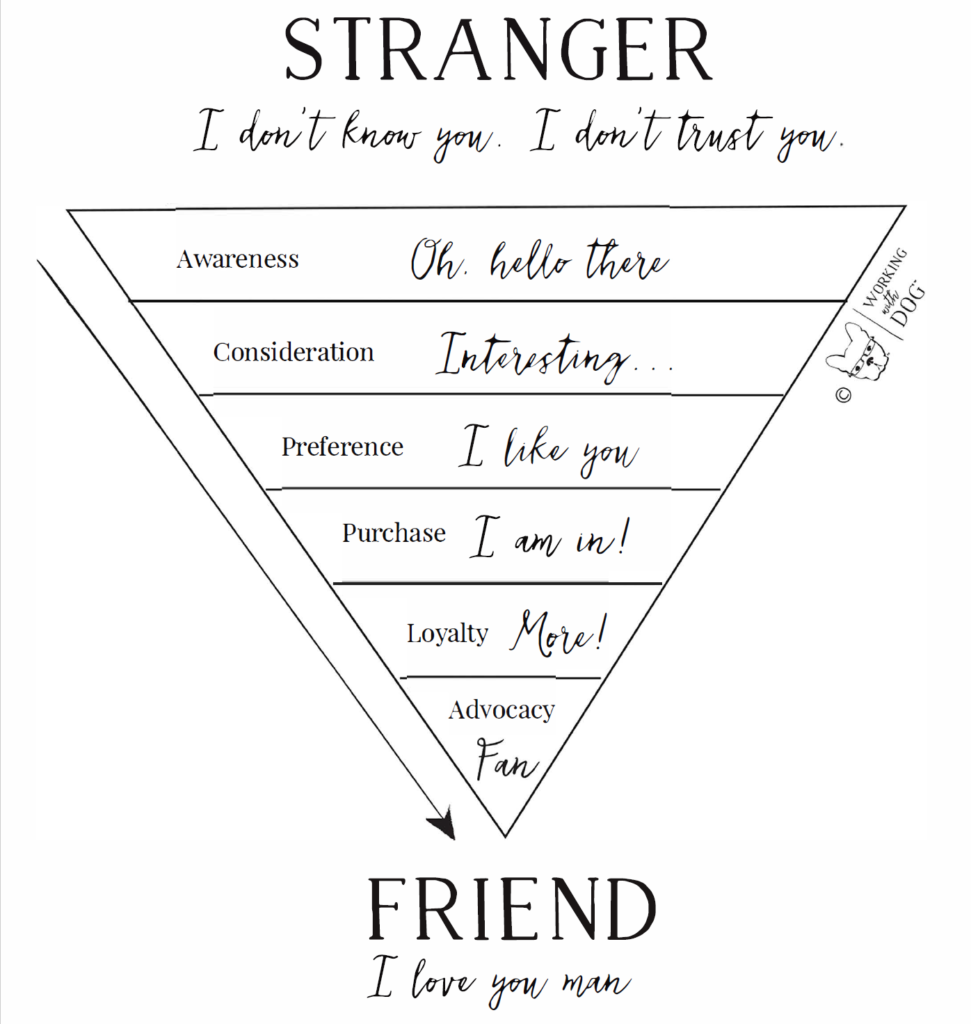 Have you heard of a “sales funnel?”
Have you heard of a “sales funnel?”
Like a physical funnel, it’s large at the top so you can pour in a lot of potentially messy stuff, and it gradually gets smaller to direct things exactly where they need to go. This is a model that dog trainers can use to answer the ever-important question – how do I get clients?
Simply put, the sales funnel for your dog training business is the journey people take when they start as strangers and turn into your clients and supporters. The goal of your sales funnel is to help you create a seamless customer experience that leads to sales and rock-solid loyal customers. Sounds great, right?
Let’s explore exactly what a sales funnel should look like and how it can work for your dog training business.
A sales funnel is about the journey you build for your audience
As a dog trainer – or a dog trainer-in-training – you know it’s important to have a great-looking website and social media pages. You can get face-to-face exposure by setting up a booth at local festivals, and you can stay in touch with newsletters via email. But how do you make sure all that web, email and face-to-face work converts into real live customers?
You’ll need to create a pathway that’s easy, helpful and inspiring for them to follow. That’s where your sales funnel becomes your guide.
Nicole Smith, co-owner of Working with Dog and a Victoria Stilwell Academy faculty member, suggests that you visualize your customer’s journey this way:

At the top of your funnel, you have heaps of strangers who don’t know you — yet! Your funnel shows the stages people go through as they get to know your business, become customers, and evolve into loyal fans. The top of your funnel holds all the people who come within range of your business. But not everyone will become a customer – and that’s ok. You want just your ideal clients to slide through your buying experience without a hitch and proceed easily to a purchase.
Here’s a walk-through of what each stage of a sales funnel means to your audience.
- Awareness: This is the “Oh, hi there!” moment, when people notice your website, event booth, newsletter, social post, or Google My Business entry for the first time.
- Consideration: If your messaging is spot-on, people who need your dog training services will stop scrolling to wonder who you might be and what you have to offer them.
- Preference: This is where potential clients think “Hmmm…I’m liking what I’m seeing here. You look like you can help me and my dog and seem smart and legitimate. I’ll give you my email address or call for your consultation.”
- Purchase: Yes! This is the conversion stage, and it’s the main goal of your funnel. It’s where you make your money. Your visitor had a seamless buying experience. But…your funnel doesn’t stop there.
- Loyalty: Why isn’t a purchase the end goal? Because you want repeat, long-term business, right? If your customers have an amazing experience with your business, they will come back for another course or keep you on their radar if they need help again in the future.
- Advocacy: This is where your most enthusiastic customers tell other people about how amazing you are, and how much you helped them with their dog. This brings more dog parents to the first stage of your funnel…and around we go again to more potential business!
Why do you need this model? It helps you follow a clear path to turn strangers into buyers when you set up or update your marketing pages and channels, or create any new campaign to bring in sales.
Why is a sales funnel important as a guide for dog trainers?
You don’t want your sales funnel to become a sieve that’s punched full of holes, leaking potential customers who are confused, bored, or lost, right? Once you are thinking of your customers’ journey as a funnel, it’s easier to improve your marketing so more people reach that magical moment of conversion to an actual customer.
Each dog training business will have a unique customer journey based on the services they offer, but let’s look at how how business marketing efforts might fit into each step of a dog training sales funnel:
Awareness: Let’s say a visitor just got a new puppy or is struggling to help their dog overcome a problem behavior. They run a search on Google for “dog trainers near me” and they find your business listed along with a bunch of others. Your meta-description (that bit of info under your business name on Google) sounds like just what they need, so they click on your business first. They have just jumped into your sales funnel instead of someone else’s! That’s a “win” for step one.
Consideration: They’ll want to see in just seconds: who you are, what your business offers, and whether you may be able to help them. If they get lost, confused, or turned off in that eyeblink or two, they’ll click back to Google to keep looking. But if your site lays out a welcome mat of info, images, and color that speaks to their needs, they’ll continue their journey deeper into your site experience.
Preference: Here’s where you convince that dog parent that your business has value that other dog trainers lack. If you have a blog, readers can immediately learn something new from you – for free! When you ask for their email address, you can offer them something valuable in return. Maybe a weekly newsletter full of training tips, a free email mini-course, or a helpful video? Your email signup or consultation appointment calendar should be easy to find and use, and of course your sales page should present your classes and products just as neatly and clearly as your main page.
Purchase: This is the goal! You’ve made it fast and easy for potential customers to review, understand, and see all of the courses and packages you offer, so they can choose the one that is best for them. Make sure your purchase process, including payment, is as smooth as possible. Your new customer will expect a confirmation window for their transaction and fast welcome email, too. If they are left hanging, they could second-guess their purchase and cancel. You want them to look forward to meeting you at their first lesson with real anticipation.
Loyalty: You may think the sales process ends now that you have the customer scheduled for a training session. It goes without saying that you’ll want their actual training experience to be as positive and personalized as possible. However, you’ll also want to nurture that customer on a marketing level by continuing to show them that they will get ongoing value from your business, even beyond their class with you. You could engage with them on social media, offer them a discount on a future class after completion of their first, and make sure the content in your newsletters and blog posts are especially helpful. Are there other ways you can think of to make yourself extra-valuable to your current customers?
Advocacy: Exceeding customer expectations is your first step toward turning customers into real fans and public advocates. Happy customers are great word-of-mouth marketers. This next step may push you a bit past your comfort zone, but you’ll also want to encourage your very best customers to post a great review on Google My Business (or Facebook, LinkedIn, etc.) or even pen a testimonial you can use on your website. Their positive feedback will reach the eyes of new pet parents, some of whom will jump into your funnel already primed to trust you!
Who is your ideal client?
By now you’re understanding that your goal isn’t to force the most people into your sales funnel, but to guide the right people toward a purchase. But who is your ideal client – and who isn’t? Take some time to think about which dog owners are the best match for your abilities, services, and preference.
Look at demographics: How old are they? Where do they live, and how far away? How much do they make? What breed and age of dog do they own? What social media channels are they on?
For example, if you specialize in in-person puppy classes, your ideal client will include puppy owners who live within driving distance. Live in a big college town? Then add first-time puppy owners 18 and up, living in an apartment or shared housing, who scrolls through TikTok instead of Facebook. Is fitness, agility, or sport training where your heart is? You’ll want your marketing to speak to people who want to have high-energy, competitive fun with their dog, are willing to purchase equipment, and are able to travel to special events.
Look at emotions and beliefs: Emotions are a strong factor in what people choose to buy. What does your ideal client value, fear, and believe? College-student puppy owners will be alarmed about their security deposit and will want help fast when their new puppy starts ripping at rugs and chewing door frames in a rented apartment. If your ideal client thinks appearances are important, they’ll be self-conscious and even ashamed if their pet isn’t well-behaved on a leash, barks unhappily all day, or lunges at other people’s pets. They’ll be looking for a trainer they can trust to help them urge their dog toward good citizenship.
Once you have an idea of who your ideal client is and what emotions drive their search for help, you’ll have a better idea of which services you should highlight, what language and images will capture their attention and make them feel welcome, where to share your social media posts, and more.
Design your customers’ journey with this Cheat Sheet
Here’s your sales funnel “cheat sheet” as a free gift from Nic’s team with Working with Dog. It’s a great start to keep top-of-mind!
Awareness:
- Ensure the first contact people have with your business – whether in person or online – immediately communicates your dog training business services and values.
- Create connections with local pet businesses – veterinarians, groomers, boarding kennels, etc. – for referrals and advertising opportunities.
Consideration:
- Choose images and colors that grab your ideal client’s attention in the first 3 seconds.. Puppy pics will grab puppy owners, active dogs will reach fitness folks…you get the idea.
- Educate and engage! Share info on social media and your blog to show you have what your ideal client wants and needs, and that they’ll want to share with others.
- To get the right people to opt into your email, offer an incentive your ideal client will value. How about a video on a quick skill they can teach their dog if they sign up?
Preference:
- Introduce your positive-training-based solutions and provide testimonials to show your business is valued and trusted.
Purchase:
- Clearly present your services, packages, and the fees on a dedicated sales page.
- Highlight your most popular service or package.
- Consider adding incentives that are time-sensitive (to add urgency) or that add special value.
Loyalty:
- Reward purchases by following up an engaging welcome email, video, or phone consultation – whatever you believe your ideal client will value and that you enjoy providing.
- Personalize your response to social media comments from past customers so both they, and others, see your special relationship.
Advocacy:
- Create VIP opportunities for satisfied clients. How about a future discount?
- Ask happy clients for a testimonial.
If marketing ideas like this fascinate you – or you find it a bit fearsome and want some help – sign up to learn more about Working with Dog from Nic and her team. See her own sales funnel in practice when you sign up here to learn about Working with Dog.
How do you find and plug leaks in your sales funnel?
So – you’ve updated your web site or created a newsletter with your ideal client and your sales funnel in mind. If you hit Publish on your website or send your newsletter and hear only crickets…don’t panic, but don’t ignore the silence, either.
This is exactly why you have a sales funnel – so you can track and test each step of your intended customer journey. Is your email list pretty sparse? Then it’s Awareness about your business you need to address: Look for new or improved ways to connect with your ideal clients. Are people visiting your website, but then leave without clicking through to another page or opting into your email list? Check out Consideration: Perhaps the info, images, and colors on your landing page don’t resonate with the clients you want to purchase your services and need a tweak.
There are also tools that can help you identify customer experience roadblocks. Analytics tools on Google and in your email marketing software (like Constant Contact, Mailchimp, Hubspot, Mailman, etc.) are great options.
Google Analytics. Potential customers are stopped in their tracks by confusing or missing navigation, broken links, or even unsettling colors or distressing images. If Google Analytics shows you that people seem to be dropping off your site from a particular page, review that page closely to resolve any roadblocks.
Email Marketing Analytics. If your emailed newsletters and promotions seem to be disappearing into a big black hole, check the analytics tool in your email system. If only a few people are opening your messages, your subject line might be on the blah side or you could be hitting “Send” on a busy email day. Depending on the tools your email system offers, you can see how many readers clicked links in your message, downloaded your attachment, or even opened your email multiple times (nice!), etc.
Utilize human “software.” Ask your friends, family and other pet professionals to kick the tires on your website and sign up for your newsletter. They can let you know if they get stuck. If you receive a negative social media comment or email reply, don’t just write the person off as toxic. They may have helped you by exposing a problem others are also encountering. And of course, when clients praise your business, ask for details and be sure thank them. What your best clients really like about your business is something you’ll definitely want to keep, repeat or enhance.
This is just the tip of the marketing iceberg. Want to learn more?
If you want to learn more marketing magic to start your new career out on the right paw, or if you want to boost your current business to the next level, reach out to us here at the Victoria Stilwell Academy. We’re well known as experts in positive dog training, but our industry-leading Dog Trainer Course covers top-level business branding and marketing, too. We’ll help you understand the human side of the dog training industry, as well as the canine side. Check us out!


